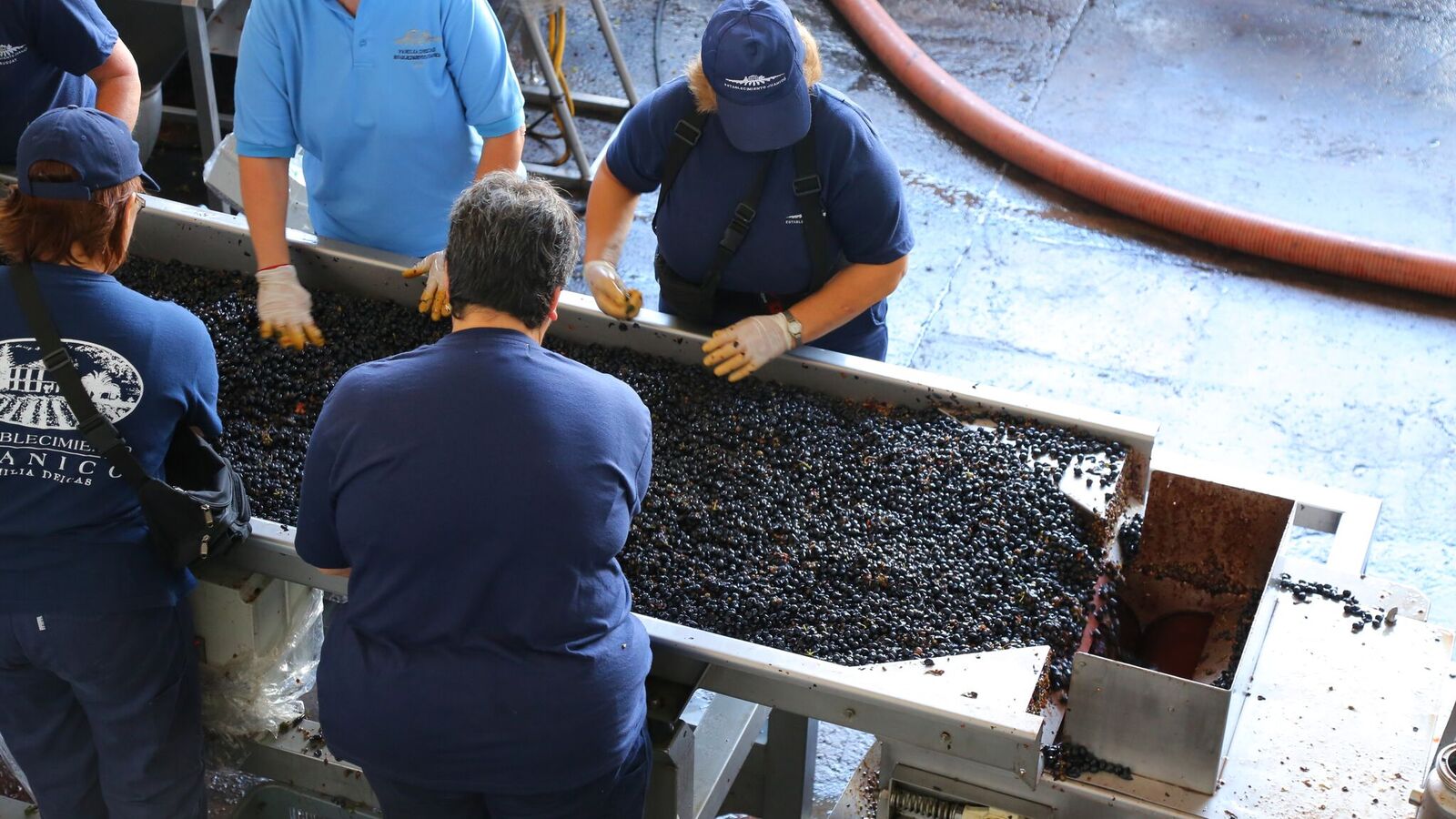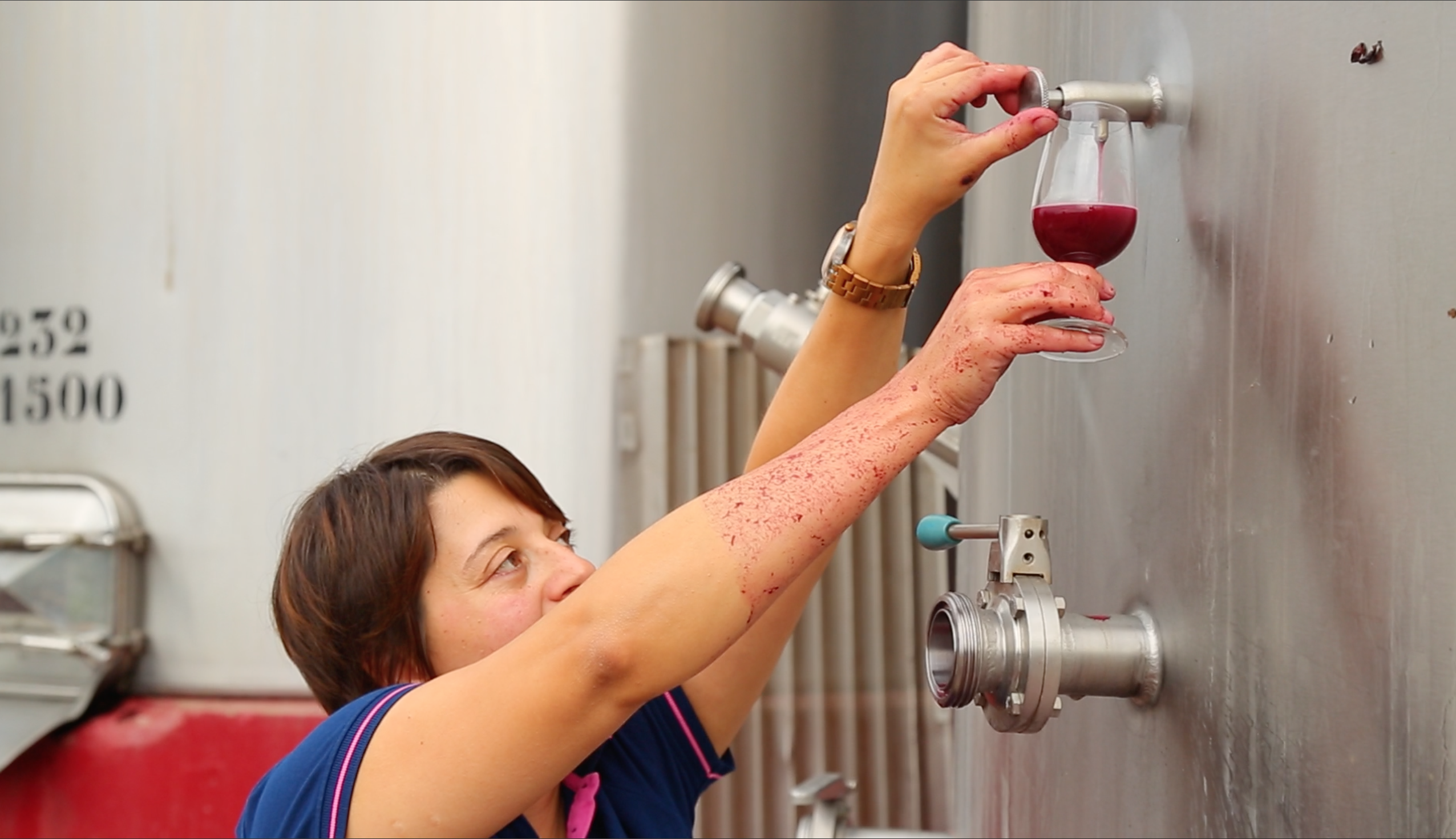PRODUCTION
Upon arrival at the winery, each cargo is weighed, a sample is taken and the vineyard information is recorded: plot, variety, harvest yield, etc.
QUALITY CONTROL
The cargo undergoes a complete analysis and a rating is assigned according to 5 qualitative technical parameters. The quality is then compared with that which was predicted by the oenologists during the vineyard visits and the destination and corresponding elaboration are confirmed or rectified.
UNLOADING THE BINS
Each plot of each variety comprises a different lot which is processed separately and not mixed with grapes from other vineyards. The “Single Vineyard” concept is applied, and those bins are collected separately from each plot until the batch or lot is complete and then processed all together.
DESTEMMING
In red and some white grapes, the winemaking process begins with destemming, that is, the separation of the stems from the grapes.
CLASSIFICATION OF THE GRAPES
For red grapes destined for long maceration times (more than 15 days), the whole grapes are individually and manually classified. The grapes that are not considered high quality are separated out, along with small pieces of stem that may have made it through the destemming.
CRUSHING
After destemming, the whole grape is lightly pressed in order to encourage it to release its juices.
COOLING
The collected must (grapes and juice) is gently transferred through stainless steel tubes to presses for white wine production or maceration tanks for red wines. The musts are transferred using modern peristaltic pumps, a technology that features “tube-in-tube” type alternators where the musts are cooled down to 5 to 8°C (41 – 47°F).
– Pre-fermentation maceration. In many cases, 4 to 6 days of cold maceration at temperatures between 5 and 10°C (41 – 50°F) is carried out prior to fermentation.
– Fermentation. The must from red grapes is fermented with selected yeasts at temperatures controlled between 24 and 32 degrees, depending on each type of wine. Remontage and racking are carried out in order to improve the extraction of anthocyanins and tannins from the grape skins in contact with the juice during fermentation.
– Post-fermentation maceration. After fermentation is complete, some wines are kept in contact with the skins and seeds for a longer time.
– In maceration and fermentation, the winemakers conduct daily analytical and organoleptic controls for each vat.
RACKING AND PRESSING
After a total maceration of two to three weeks, the wine is de-vatted and the pomace is transported to the press with forklifts and conveyor belts, instead of by pump. This ensures the pressed wines attain high quality.
MICRO-OXYGENATION
In the structuring phase of red wines, oxygen plays an important role. Aerated racking is complemented with modern micro-oxygenation techniques, which allows for good stabilization of anthocyanins and tannins. The best results can be seen with Tannat wines.
GRAPE PRESS
The chilled musts are macerated for a few hours and then pressed in modern pneumatic presses, separating the juice. The pressing is often carried out in a sealed environment where the oxygen in the chamber is replaced with carbon dioxide to avoid any possible oxidation of the aromas.
WHOLE GRAPE PRESS
As the gentle pressure of the pneumatic presses does not extract anything from completely ripe stems, white grapes are often maintained fully intact until they reach the press where they are pressed whole.
CLARIFICATION
Once collected, the juice is cooled to 5 degrees and deposited in isolated tanks where natural clarification occurs between 12 and 24 hours. The clear juice is then transferred to the fermentation tanks.
FERMENTATION
The fermentation tanks have cooling jackets through which cold water circulates, controlling the temperature of fermentation of white and rosé musts between 12 and 18 degrees, depending on the varietal.
Ice water is constantly produced in a cold room to be pumped to the cooling jackets for the fermentation tanks.
BARREL FERMENTATION
Some selections of Chardonnay and Viognier musts are fermented directly in first use oak barrels in the old underground cellars.
WASTE RECYCLING
Although winkemaking is a very natural process, it can have some environmental impacts which are controlled to the greatest degree by Establecimiento Juanicó. Liquid waste is therefore minimal and all solid waste is recycled. The pomace and stems are scattered throughout the vineyards, restoring the earth with a large part of the nutrients consumed by the plants. This also avoids the need for chemical fertilizers, therefore complying with the principles of organic agriculture.
BARREL AGING
The white wines fermented in barrels are aged for 3 to 6 months, during which numerous “batonages” are carried out to boost structure and creaminess. The fermentation of red wines produced for aging takes place in French and American oak barrels. Depending on the type of wine desired, it ages from 12 to 36 months in barrels in underground cellars.
The bottling of the wines follows a rigorous HACCP system (Hazard Analysis Critical Control Point), through which all critical points for quality are controlled.
We are certified for ISO 9001:2008, ISO 14001:2004, ISO 22000:2005 and OHSAS 18001:2007.
BOTTLING
The bottling line is small and the process is directly supervised by the responsible winemakers. The glass of each bottle is printed on in order to ensure complete traceability of each product.
After bottling, the wine is stored in crates in sheds at controlled temperatures where it finishes aging in the bottle for 2 to 24 months, depending on the wine.
LABELING
The bottles are labeled before being sent to market.


